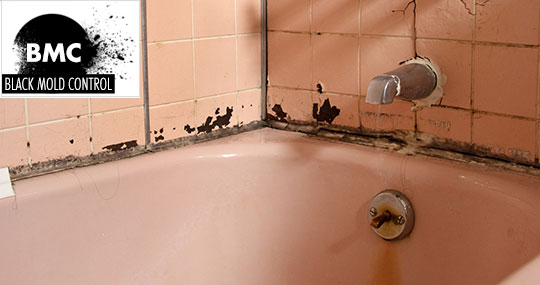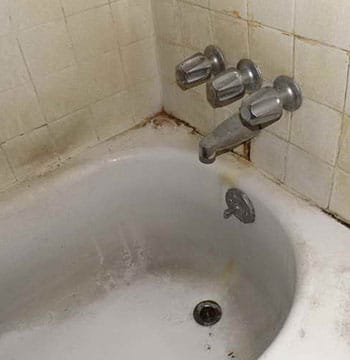Mold in your home can be a serious issue and even dangerous to your family’s health if left untreated. Some rooms are more susceptible to mold than others and danger zones usually include the kitchen, basement and bathrooms of homes. In particular, bathtub mold can be pervasive and difficult to remove so review the guide below for helpful information regarding what to do if you find mold in your home bathtub.

Table of Contents
Causes of household and bathroom mold
All mold is a type of fungus and requires a food source and moisture to grow and thrive. Food sources for mold usually come in some sort of organic material so paper, porous plastics and wood are all hospitable breeding grounds for mold. Most home mold infestations are caused by prevalent moisture and can be onset by floods or periods of heavy humidity. Biological pollutants are also a contributing factor so eradicating bathtub mold means first identifying the source.
It’s often advisable to have internal air ducts inspected for mold or moisture and some people prefer to have a complete window and door inspection as well to ensure moisture isn’t seeping in undetected. Specific causes of mold in your bathtub may include porous grout that sucks up excess moisture and areas that don’t drain properly, creating puddles of water that are perfect for mold growth. Some homeowners may find that the longer they go without a regular bathtub cleaning, the more likely black mold is to show up on their tub surfaces. Read more on mold and mildew.
How to remove mold and disinfect the area
Once you’ve identified bathtub mold, removing it is a simple step-by-step process.
Step 1: The first step is to thoroughly dry the mold in your bathtub which means wiping the surface of your tub and sealing off your bathroom to any excess moisture. Different types of mold respond to different cleaning agents but if you have black mold in your bathtub, the most common infestation, a simple bleach solution should suffice.
Step 2: Mix bleach and water together to form a solution then while wearing rubber gloves and goggles, thoroughly wipe the surface of your bathtub to kill all remaining mold. It’s imperative never to mix bleach and ammonia as this can be hazardous.
Step 3: After scrubbing the bathtub clean with a plastic brush and bleach, use pure water to rinse down the area to ensure all mold and cleaning agents are removed from the surface. If cleaned properly, a visual inspection of the area should determine the mold has been removed.
Step 4: The final step of your bathtub mold removal is to then thoroughly dry the bathtub then make sure no moisture re-enters the room for at least 24-hours. The combination of decreased moisture and bleach should thoroughly remove the mold in your bathtub as well as disinfect your bathtub area.
Tools and protective gear for mold removal
When working with mold and cleaning agents it’s important to have the proper safety equipment. Aside from rubber gloves it may be necessary to invest in rubber boots, plastic goggles and even a mouth and nose mask. This is to ensure you don’t breath in any hazardous chemicals as well as mold spores. It’s best to use a stiff brush to clean the black mold in your bathtub and any porous items used in the cleaning process like a rag should be thrown out when cleaning is completed.
What is the best bathtub mold cleaner?
One of the best bathtub mold cleaners is Lysol Power Free Bathroom Cleaner. This product uses the power of hydrogen peroxide instead of bleach to clean and disinfect. Just for insurance you’ll have to put on gloves and protective gear when cleaning and the bubbles will clean dirt and fungus from your tub. This product also takes care of 99.9% of bacteria and bathroom viruses.
As previously stated, never mix ammonia and bleach together as this combination can produce hazardous fumes. It’s also advisable to open any windows and doors in the room you’re cleaning to avoid inhaling as much bleach as possible. Never touch bathtub mold with your hands and always use rubber gloves when dealing with cleaning agents. As always, when working in a bathroom setting, wear rubber soled shoes or boots to avoid slipping and falling.

How to remove mold naturally?
Walking into the bathroom and finding mold can be distressing. Although bleach might come to your mind as the best cleaning solution, there are other options that get the job done and will keep the fungus from coming back. Since bleach basically lightens the color and cleans the surface, there are probably spores living under the surface that will come back quickly. A healthier way to remove dirt and grime and keep the bathtub clean is to use more natural products.
Use a vinegar solution
One of the best ways to clean the bathtub, caulk, and grout is with a vinegar solution. In a spray bottle or bucket, combine 1 part vinegar to 9 parts of water. Either spray the solution directly on the tub or use a sponge or cloth to soak the areas. Use plenty of solution and then let it sit for 15 minutes or longer depending on the severity of the infestation. Finally, use water for the removal of the solution and pat dry. If you notice the black fungus coming back, use a solution of full vinegar or another natural product like hydrogen peroxide to keep the area clean.
Black mold near your bathtub
You might think finding black mold in the bathroom is confined to the grout and caulk. Unfortunately, black mold can also be found in the jets and drain of your porcelain or other types of bathtubs. When using a cleaning product, you need to pay special attention to these areas. Spray the cleaner directly on spot and scrub with a soft brush. Be sure to rinse and wipe away all the grime before using the jets. You also need to inspect all areas of tile. If your toilet is close to the tub, it’s sometimes hard to see mold growing in the corners.
User Review of the Home Armor Instant Mold and Mildew Stain Remover
Did you like the video and want to try Home Armor Instant Mold Remover? Here is the [Amazon Link].
Mold and bathtub materials
Bathtubs are made from different materials and you need to understand how to clean without damaging the bath. You should use a commercial cleaning removal solution on a porcelain enameled steel tub. Do not use bleach or vinegar. When cleaning an acrylic tub you need to use a soft cloth and plenty of water. These tubs usually only require a gentle cleaner and should be dried completely, especially around the drain. You can clean a fiberglass tub using a variety of cleaners. Use the vinegar solution for removal of mold and grime and rinse with water. When cleaning enameled cast iron, you need to be careful so you don’t discolor the surface. A mild commercial cleaner will work well the removal of stains and be sure to rinse completely and dry.
Tips for preventing and detecting mold
 Preventing mold in your tub is often easier than the process of bathtub mold removal. The first and most important step in mold prevention is eradicating excess moisture which may mean having your bathroom inspected for ventilation issues. Leaky windows and doors as well as a faulty air-conditioning ventilation system may mean your bathroom is moister than it should be which leaves mold rife for growth.
Preventing mold in your tub is often easier than the process of bathtub mold removal. The first and most important step in mold prevention is eradicating excess moisture which may mean having your bathroom inspected for ventilation issues. Leaky windows and doors as well as a faulty air-conditioning ventilation system may mean your bathroom is moister than it should be which leaves mold rife for growth.
Another crucial step in moisture prevention is to stop any condensation from forming, so check your room thoroughly to ensure no moisture beads are forming, even if they happen on hard surfaces. Porous and organic surfaces are perfect locations for mold to grow, so make sure all parts of your bathtub are properly sealed. Cracks and crevices make great surfaces for mold so consider resealing your bathtub if necessary to make sure its surface consists only of hypoxic plastic or hard sealed tile.
The last step in black mold prevention is regular cleaning – you should aim to thoroughly bleach clean your bathtub at least once every three months to inhibit new mold growth and kill any existing mold. The easiest way to tell if mold is present in your bathroom is by taking a moment to visually inspect all surfaces and also to smell test for musky, dank odors. A professional may be needed to determine exactly which type of mold is present in the home.
Mold is a common household infestation and can usually be taken care of rather easily with a few home products. If you suspect the mold in your bathroom is something other than standard black mold or if after removal your mold returns you may want to call on a professional to give you advice. If untreated, some strains of mold can be hazardous to respiratory systems and can spread further than the eye can detect so if you’re doubtful you’ve thoroughly removed the mold, consult an expert.
